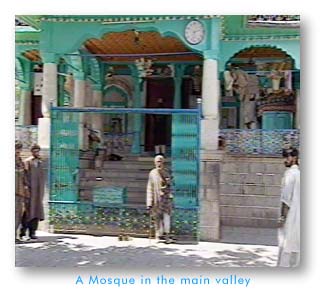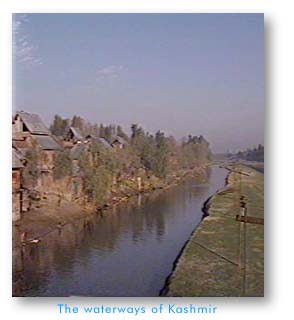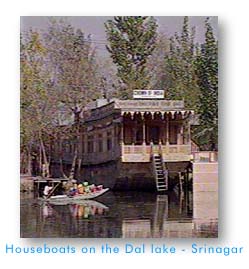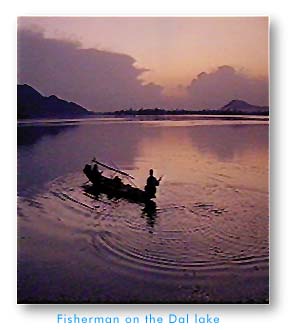Karamjeet Singh's Himalayan Home



Geologists opine that the vale of Kashmir was once a huge lake called the Karewa. The
Karewa was formed when the Jhelum was blocked by the rising Pir-Panjaals in one of the
periodic phases of Himalayan uplift. The river finally escaped it's encirclement by gouging
a deep cut across the Pir Paanjaal at Uri and when the waters of the Karewa drained here
from what is termed the Jhelum gap, the valley of Kashmir came into being.
Mankind has been around in the Kashmir valley for a long long time but the early history
of Kashmir is lost in the mists of legend. The valley's name is often attributed to the Sage
Kashyap, being a corruption of the original Kashyapamaar.
Kashmiri history becomes clearer after the advent of the Mauryan empire under Ashoka.
The great emperor is said to have built the city of Srinagar around the year 250 B.C.
During this period Buddhism spread in Kashmir, taking firm root by the time of the
Kushan empire in the 1st century A.D. From here Buddhism spread to Ladakh, Tibet, and
Central Asia, beyond, furthered by Kashmiri scholars and monks and artists.
The famous Chinese traveller visited the Kashmir valley and Ladakh in the 7th century in
order to study Buddhism. He stayed in Kashmir for two years and provides many accounts
of the lives of the people in those times. According to him there were over 5,000 monks in
the valley. A large number considering the low population in the 7th century.
Islam came to the valley in the 14th century, through the combined influence of Saiyyad  preachers and the muslim rule established in the middle of that century. By the end of the
century, barring small sections of the Hindu orthodoxy, the valley was almost totally
muslim. Buddhism now, retreated behind the Himalayas.
preachers and the muslim rule established in the middle of that century. By the end of the
century, barring small sections of the Hindu orthodoxy, the valley was almost totally
muslim. Buddhism now, retreated behind the Himalayas.
Later came the Moghuls. They introduced an elaborate system of village level revenue
during the close of the 16th century. The moghuls left a permanent mark on the history of
Kashmir. Akbar built the Hariparbat fort as a famine relief measure. Jehangir laid out the
famous Shalimar garden and introduced the Chinar tree from Iran.
The modern history of Kashmir is centered around the Dogra dynasty. Maharaj Gulab  Singh got the Jagir of Jammu from Maharaja Ranjit Singh in 1820 and two years later he
became the full fledged ruler of Jammu. In march 1846, the aftermath of the Anglo-Sikh
war saw Maharaja Gulab Singh of Jammu acquire control of modern India's largest
princely state, Jammu and Kashmir, which included Ladakh and Baltistan.
Singh got the Jagir of Jammu from Maharaja Ranjit Singh in 1820 and two years later he
became the full fledged ruler of Jammu. In march 1846, the aftermath of the Anglo-Sikh
war saw Maharaja Gulab Singh of Jammu acquire control of modern India's largest
princely state, Jammu and Kashmir, which included Ladakh and Baltistan.
Kashmir's long and multifaceted history is reflected in it's craft traditions. From the
Muryan and Kushan period, through a period of Tibetan influence, before finally setting
it's sights on the west, towards Mecca, Kashmir recieved the most highly developed
influences of Hindu, Buddhist and Islamic cultures. Skilled workers from Central Asia and
Iran provided a remarkable cross fertilization. Carpet weaving, finely painted papier
mache, paper making, weaving of shawls of Pashmina and other fine wools, metal work
and jewellry, all flourished in the suceeding centuries.
Weaving of both carpets and the famed Kashmir shawl are traditions and techniques
handed down over the generations by the master weavers of Persia. The techniques, the  Taleem or the instruction sheet, and the Karkhanas remain as they must have been for
centuries. The weavers chant the taleem while working. Wages are paid by the thousand
knots and of course the more knots per square inch, the finer the ultimate result.
Taleem or the instruction sheet, and the Karkhanas remain as they must have been for
centuries. The weavers chant the taleem while working. Wages are paid by the thousand
knots and of course the more knots per square inch, the finer the ultimate result.
The patterns are reproduction and adaptations of Persian, Turkish and Turkman motifs and
designs. What makes Kashmiri carpets famous the world over are the faithfulness to the
original elaborate designs and the quality of the craftsmanship. Trained from an early age
when fingers are nimble many master weavers are in their early thirties.
The forty odd Basholi miniatures housed in the Amar Mahal Palace museum in Jammu constitute one of the
finest collections of hill miniatures in the world. These detail the epic love saga of Nala
and Damayanti and are priceless remnants of the artistic heritage of the Hindu Himalaya.
 Each frame is a tapestry of love, betrayal and passion liberally embellished with gold and
exquisitely detailed.
Each frame is a tapestry of love, betrayal and passion liberally embellished with gold and
exquisitely detailed.
Kashmiri social dynamics are more akin to plainspeople than to other Himalayan hill
peoples. Complex and highly stratified, despite the age old conversion to Islam, Kashmiri
society is layered in caste, considerations that generally come to play during marriages etc.
Surprisingly, Kashmiri society never really had a warrior or trading class, though tourist
times saw all classes take to trading like a duck to water.
The lakes and waterways of Kashmir had a big effect on shaping the people leading to the
growth of a significant boat community whose unusual lifestyle has been moulded by their
surroundings. Living their lives on the water they are a truly unique Himalayan community. The fascination of tourists with houseboats led to the emergence of
entrepreneurs within this community who converted their houseboat into luxurious floating
hotels.
community. The fascination of tourists with houseboats led to the emergence of
entrepreneurs within this community who converted their houseboat into luxurious floating
hotels. Most of the lakes of Kashmir are remnants of ancient oxbows created by the river Jhelum
as it meanders across the valley floor and the present lakes are shrunken remnants of their
past selves. The Dal lake, for example, has shrunk in the past 50 years to half it's size,
from 22 to 11 square kilometers. In the intervening years, the lake has changed in other
fashions too. The classic example of environmental degradation in a Himalayan lake eco-
system today, is the Dal lake in Srinagar.
Most of the lakes of Kashmir are remnants of ancient oxbows created by the river Jhelum
as it meanders across the valley floor and the present lakes are shrunken remnants of their
past selves. The Dal lake, for example, has shrunk in the past 50 years to half it's size,
from 22 to 11 square kilometers. In the intervening years, the lake has changed in other
fashions too. The classic example of environmental degradation in a Himalayan lake eco-
system today, is the Dal lake in Srinagar.
The process known as Eutrophication has set in. Eutrophication results when the lake
waters become artificially enriched with nutrients, causing abnormal plant growth. Runoff
of chemical fertilizers from the vast drainage basin around the lake, sewage and other
oxygen demanding wastes, which brings in 15 tons of phosphorous and 300 tons of  nitrogen every year, all these factors combine to place the lake's internal life processes
under severe stress. Oxygen levels fall, the fish die out and aesthetically also the effect is
not very pleasing. Decaying organic matter produces disagreeable odors and the eye is
offended by unsightly green scum of algae and weed infested waterways.
nitrogen every year, all these factors combine to place the lake's internal life processes
under severe stress. Oxygen levels fall, the fish die out and aesthetically also the effect is
not very pleasing. Decaying organic matter produces disagreeable odors and the eye is
offended by unsightly green scum of algae and weed infested waterways.


This page hosted by
 Get your own Free Home Page
Get your own Free Home Page
Web Page Design and Images Copyrightę: Karamjeet Singh




 preachers and the muslim rule established in the middle of that century. By the end of the
century, barring small sections of the Hindu orthodoxy, the valley was almost totally
muslim. Buddhism now, retreated behind the Himalayas.
preachers and the muslim rule established in the middle of that century. By the end of the
century, barring small sections of the Hindu orthodoxy, the valley was almost totally
muslim. Buddhism now, retreated behind the Himalayas. Singh got the Jagir of Jammu from Maharaja Ranjit Singh in 1820 and two years later he
became the full fledged ruler of Jammu. In march 1846, the aftermath of the Anglo-Sikh
war saw Maharaja Gulab Singh of Jammu acquire control of modern India's largest
princely state, Jammu and Kashmir, which included Ladakh and Baltistan.
Singh got the Jagir of Jammu from Maharaja Ranjit Singh in 1820 and two years later he
became the full fledged ruler of Jammu. In march 1846, the aftermath of the Anglo-Sikh
war saw Maharaja Gulab Singh of Jammu acquire control of modern India's largest
princely state, Jammu and Kashmir, which included Ladakh and Baltistan. Taleem or the instruction sheet, and the Karkhanas remain as they must have been for
centuries. The weavers chant the taleem while working. Wages are paid by the thousand
knots and of course the more knots per square inch, the finer the ultimate result.
Taleem or the instruction sheet, and the Karkhanas remain as they must have been for
centuries. The weavers chant the taleem while working. Wages are paid by the thousand
knots and of course the more knots per square inch, the finer the ultimate result. Each frame is a tapestry of love, betrayal and passion liberally embellished with gold and
exquisitely detailed.
Each frame is a tapestry of love, betrayal and passion liberally embellished with gold and
exquisitely detailed. community. The fascination of tourists with houseboats led to the emergence of
entrepreneurs within this community who converted their houseboat into luxurious floating
hotels.
community. The fascination of tourists with houseboats led to the emergence of
entrepreneurs within this community who converted their houseboat into luxurious floating
hotels. Most of the lakes of Kashmir are remnants of ancient oxbows created by the river Jhelum
as it meanders across the valley floor and the present lakes are shrunken remnants of their
past selves. The Dal lake, for example, has shrunk in the past 50 years to half it's size,
from 22 to 11 square kilometers. In the intervening years, the lake has changed in other
fashions too. The classic example of environmental degradation in a Himalayan lake eco-
system today, is the Dal lake in Srinagar.
Most of the lakes of Kashmir are remnants of ancient oxbows created by the river Jhelum
as it meanders across the valley floor and the present lakes are shrunken remnants of their
past selves. The Dal lake, for example, has shrunk in the past 50 years to half it's size,
from 22 to 11 square kilometers. In the intervening years, the lake has changed in other
fashions too. The classic example of environmental degradation in a Himalayan lake eco-
system today, is the Dal lake in Srinagar. nitrogen every year, all these factors combine to place the lake's internal life processes
under severe stress. Oxygen levels fall, the fish die out and aesthetically also the effect is
not very pleasing. Decaying organic matter produces disagreeable odors and the eye is
offended by unsightly green scum of algae and weed infested waterways.
nitrogen every year, all these factors combine to place the lake's internal life processes
under severe stress. Oxygen levels fall, the fish die out and aesthetically also the effect is
not very pleasing. Decaying organic matter produces disagreeable odors and the eye is
offended by unsightly green scum of algae and weed infested waterways.
